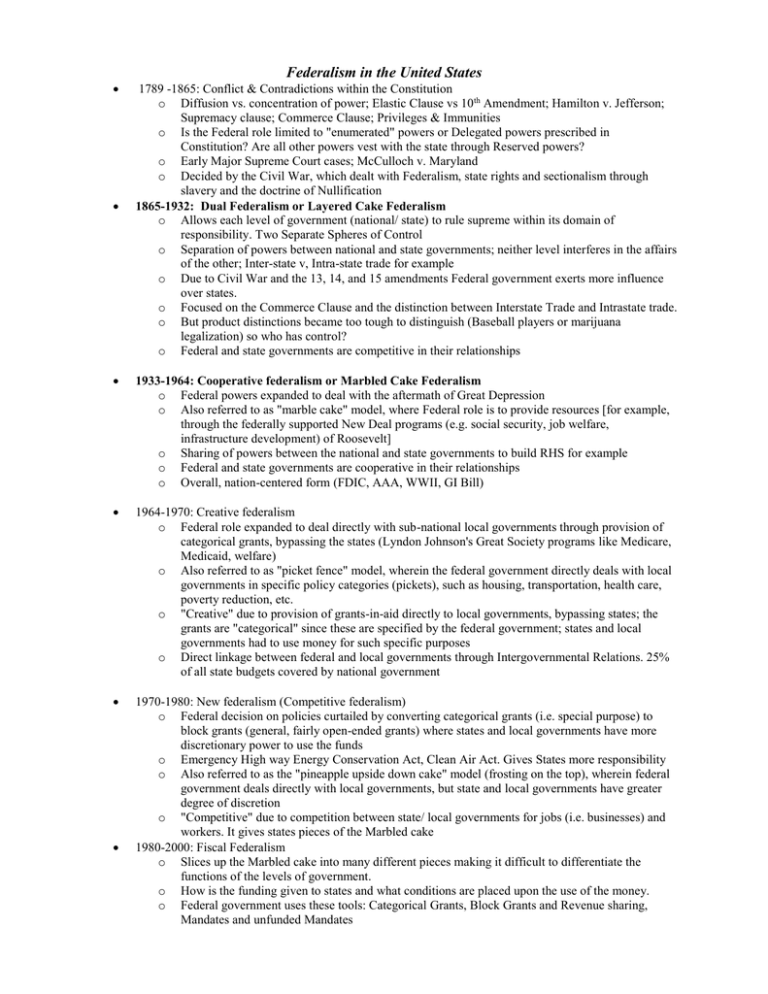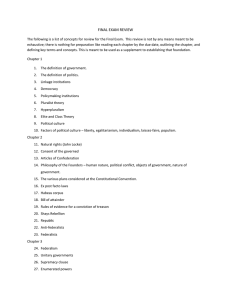Forms of federalism in the United States
advertisement

Federalism in the United States 1789 -1865: Conflict & Contradictions within the Constitution o Diffusion vs. concentration of power; Elastic Clause vs 10 th Amendment; Hamilton v. Jefferson; Supremacy clause; Commerce Clause; Privileges & Immunities o Is the Federal role limited to "enumerated" powers or Delegated powers prescribed in Constitution? Are all other powers vest with the state through Reserved powers? o Early Major Supreme Court cases; McCulloch v. Maryland o Decided by the Civil War, which dealt with Federalism, state rights and sectionalism through slavery and the doctrine of Nullification 1865-1932: Dual Federalism or Layered Cake Federalism o Allows each level of government (national/ state) to rule supreme within its domain of responsibility. Two Separate Spheres of Control o Separation of powers between national and state governments; neither level interferes in the affairs of the other; Inter-state v, Intra-state trade for example o Due to Civil War and the 13, 14, and 15 amendments Federal government exerts more influence over states. o Focused on the Commerce Clause and the distinction between Interstate Trade and Intrastate trade. o But product distinctions became too tough to distinguish (Baseball players or marijuana legalization) so who has control? o Federal and state governments are competitive in their relationships 1933-1964: Cooperative federalism or Marbled Cake Federalism o Federal powers expanded to deal with the aftermath of Great Depression o Also referred to as "marble cake" model, where Federal role is to provide resources [for example, through the federally supported New Deal programs (e.g. social security, job welfare, infrastructure development) of Roosevelt] o Sharing of powers between the national and state governments to build RHS for example o Federal and state governments are cooperative in their relationships o Overall, nation-centered form (FDIC, AAA, WWII, GI Bill) 1964-1970: Creative federalism o Federal role expanded to deal directly with sub-national local governments through provision of categorical grants, bypassing the states (Lyndon Johnson's Great Society programs like Medicare, Medicaid, welfare) o Also referred to as "picket fence" model, wherein the federal government directly deals with local governments in specific policy categories (pickets), such as housing, transportation, health care, poverty reduction, etc. o "Creative" due to provision of grants-in-aid directly to local governments, bypassing states; the grants are "categorical" since these are specified by the federal government; states and local governments had to use money for such specific purposes o Direct linkage between federal and local governments through Intergovernmental Relations. 25% of all state budgets covered by national government 1970-1980: New federalism (Competitive federalism) o Federal decision on policies curtailed by converting categorical grants (i.e. special purpose) to block grants (general, fairly open-ended grants) where states and local governments have more discretionary power to use the funds o Emergency High way Energy Conservation Act, Clean Air Act. Gives States more responsibility o Also referred to as the "pineapple upside down cake" model (frosting on the top), wherein federal government deals directly with local governments, but state and local governments have greater degree of discretion o "Competitive" due to competition between state/ local governments for jobs (i.e. businesses) and workers. It gives states pieces of the Marbled cake 1980-2000: Fiscal Federalism o Slices up the Marbled cake into many different pieces making it difficult to differentiate the functions of the levels of government. o How is the funding given to states and what conditions are placed upon the use of the money. o Federal government uses these tools: Categorical Grants, Block Grants and Revenue sharing, Mandates and unfunded Mandates o o States become dependent on national government for funding (education, healthcare, welfare) States cannot deviate or reform system without Federal government permission.








